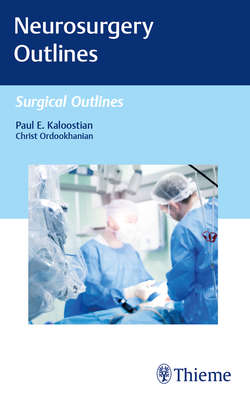Читать книгу Neurosurgery Outlines - Paul E. Kaloostian - Страница 45
На сайте Литреса книга снята с продажи.
Surgical Procedure for Cervical Spine (Laminoplasty)
Оглавление1. Administer propranolol 20 mg orally four times a day for 3 days to patient preoperation
2. Informed consent signed, preoperative labs normal, no Aspirin/Plavix/Coumadin/NSAIDs/Celebrex/Naprosyn/other anticoagulants and anti-inflammatory drugs for at least 2 weeks
3. Administer preoperative prophylactic intravenous (IV) antibiotics
4. Appropriate intubation and sedation and lines (if necessary, as per the anesthetist)
5. Patient placed prone on gel rolls, with head clamped via Mayfield pins, pressure points padded, and any hair clipped over upper cervical region
6. Neuromonitoring may be required to monitor nerves (if necessary and indicated)
7. Eyes taped closed and Bair Hugger covers upper body
8. Time out is performed with agreement from everyone in the room for correct patient and correct surgery with consent signed
9. C-arm fluoroscopy equipment set up in operation zone
10. Make an incision over the vertebrae where laminoplasty is to be performed:
a. Prepare to utilize one level above and below the AVM nidus or AVF shunt
b. Extension to ipsilateral pedicle performed if deemed necessary to enhance lateral of the AVM nidus or AVF shunt
11. Perform subperiosteal dissection of muscles bilaterally to expose the vertebra
12. Once the bone is exposed, it is best to localize and verify the correct vertebra via X-ray or fluoroscopic imaging and confirming with at least two people in the room
13. Bovie electrocautery is used to progress dissection toward the spine and to attain hemostasis, with the help of bipolar forceps
14. Move musculature around vertebra laterally and downward to expose the dura
15. Utilize self-retaining retractors to keep everything in place
16. Open the dura, followed by the arachnoid
17. Clip the arachnoid to the dural edges using self-retaining retractors to reveal the AVM
18. Video-angiography (typically with ICG) is used to visualize the blood flow through the AVM
19. If the AVM nidus is intraparenchymal in its entirety, prepare to perform a myelotomy (midline dorsal, dorsal root entry zone, lateral, and anterior midline types). Otherwise, continue with the laminoplasty procedure (typically a pial resection).
20. Using the surgical suction and nonstick bipolar forceps, the pia arachnoid is revealed
21. Cut and coagulate the appropriate vessels
22. Separate AVM from the spinal cord using surgical scissors, bipolar, and suction
23. Several nerve rootlets will be tangled with the AVM (they may be tangled with dorsal nerve roots) and must be removed by necessity; others may be left unaltered
24. Cut the dentate ligament where it is attached to the AVM
25. The spinal canal is further exposed, revealing the feeders of the AVM
26. Use video-angiography to confirm no further shunting of the arterial venous blood
27. Close the dura as well as the subcutaneous tissues after the laminoplasty is successfully performed
28. Close the skin with suture, skin-glue, steri-strips, or surgical staples
29. Postoperative injection of the vertebral artery and the thyrocervical trunk demonstrate that the AVM has been treated
